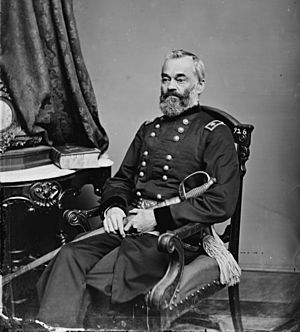Samuel P. Heintzelman facts for kids
Quick facts for kids
Samuel Peter Heintzelman
|
|
|---|---|
 |
|
| Born | September 30, 1805 Manheim, Pennsylvania |
| Died | May 1, 1880 (aged 74) Washington, D.C. |
| Place of burial | |
| Allegiance | United States of America |
| Service/ |
United States Army Union Army |
| Years of service | 1826–1869 |
| Rank | |
| Commands held | III Corps XXII Corps |
| Battles/wars | Seminole War
|
| Signature | |
Samuel Peter Heintzelman (born September 30, 1805 – died May 1, 1880) was an important United States Army general. He served in many conflicts, including the Seminole War, the Mexican–American War, and the American Civil War. During the Civil War, he became a key leader, commanding a large group of soldiers called a corps.
A World War II ship, the SS Samuel Heintzelman, was named in his honor. It was launched on September 30, 1942.
Contents
Early Life and Military Beginnings
Samuel Heintzelman was born in Manheim, Pennsylvania. He attended the United States Military Academy and graduated in 1826. After West Point, he became a second lieutenant in the U.S. Army.
He served in different forts along the northern border of the United States. In 1833, he was promoted to first lieutenant. He worked in Florida during the Second Seminole War. This war was fought against the Seminole Native American people.
Service in the Mexican-American War
In 1847, Heintzelman joined General Winfield Scott's army in Mexico. He took part in several battles during the Mexican–American War. For his actions, he was given a special promotion to major. This type of promotion, called a brevet, was an honorary rank.
After the war, he traveled around Cape Horn to California. He spent several years serving in California and the Arizona Territory.
Battles in the American West
In 1851, Major Heintzelman led soldiers in the Yuma War. This conflict was against the Yuma people in Arizona. His group helped establish Fort Yuma. Peace was made in October 1852. He was recognized for his leadership in this campaign.
He was promoted to major of the 1st U.S. Infantry in 1855. He then served on the Texas border. In 1859, he helped defeat the forces of Juan Cortina during the First Cortina War in Texas.
Heintzelman was also the first president of the Sonora Exploring and Mining Company. This company started a mining town in southern Arizona.
Civil War Leadership
When the American Civil War began, Heintzelman was promoted to colonel. Soon after, in May 1861, he became a brigadier general. He led a division of soldiers at the First Battle of Bull Run in July. During this battle, he was wounded in the elbow.
In March 1862, President Abraham Lincoln organized the Union Army into corps. Heintzelman was given command of the III Corps of the Army of the Potomac. His corps played a big role in the Peninsula Campaign.
Key Battles and Challenges
His corps was important during the siege of Yorktown. Heintzelman and another commander, Fitz John Porter, were among the first to use observation balloons. These balloons helped them see enemy positions.
The III Corps fought bravely at the Williamsburg and Fair Oaks. They also saw action at Oak Grove and Glendale. Heintzelman received more promotions for his actions in these battles. At the Battle of Glendale, he was bruised in the wrist.
After several tough battles, Heintzelman was promoted to major general. However, some felt he was not aggressive enough as a leader. His corps suffered heavy losses at the Second Battle of Bull Run.
Later War Service and Retirement
In September 1862, Heintzelman was removed from his command. He was considered too old and not aggressive enough for the front lines. For the rest of the war, he commanded the defenses around Washington, D.C.
After the war ended in 1865, Heintzelman returned to his regular army rank of colonel. He served on military boards and helped with Reconstruction efforts in Texas.
He retired from the army on February 22, 1869. He was given a final promotion to major general upon retirement. Samuel Heintzelman passed away in Washington, D.C., on May 1, 1880, at age 74. He is buried in Forest Lawn Cemetery in Buffalo, New York.
His grandson, Stuart Heintzelman, also became a major general. He served in World War I.
Images for kids

